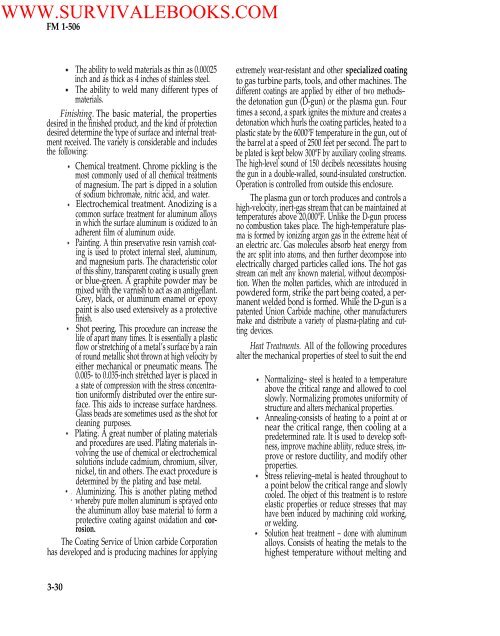FM 1-506 Fundamentals of Aircraft Power Plants ... - Survival Books
FM 1-506 Fundamentals of Aircraft Power Plants ... - Survival Books
FM 1-506 Fundamentals of Aircraft Power Plants ... - Survival Books
Create successful ePaper yourself
Turn your PDF publications into a flip-book with our unique Google optimized e-Paper software.
WWW.SURVIVALEBOOKS.COM<strong>FM</strong> 1-<strong>506</strong>The ability to weld materials as thin as 0.00025inch and as thick as 4 inches <strong>of</strong> stainless steel.The ability to weld many different types <strong>of</strong>materials.Finishing. The basic material, the propertiesdesired in the finished product, and the kind <strong>of</strong> protectiondesired determine the type <strong>of</strong> surface and internal treatmentreceived. The variety is considerable and includesthe following:Chemical treatment. Chrome pickling is themost commonly used <strong>of</strong> all chemical treatments<strong>of</strong> magnesium. The part is dipped in a solution<strong>of</strong> sodium bichromate, nitric acid, and water.Electrochemical treatment. Anodizing is acommon surface treatment for aluminum alloysin which the surface aluminum is oxidized to anadherent film <strong>of</strong> aluminum oxide.Painting. A thin preservative resin varnish coatingis used to protect internal steel, aluminum,and magnesium parts. The characteristic color<strong>of</strong> this shiny, transparent coating is usually greenor blue-green. A graphite powder may bemixed with the varnish to act as an antigellant.Grey, black, or aluminum enamel or epoxypaint is also used extensively as a protectivefinish.Shot peering. This procedure can increase thelife <strong>of</strong> apart many times. It is essentially a plasticflow or stretching <strong>of</strong> a metal’s surface by a rain<strong>of</strong> round metallic shot thrown at high velocity byeither mechanical or pneumatic means. The0.005- to 0.035-inch stretched layer is placed ina state <strong>of</strong> compression with the stress concentrationuniformly distributed over the entire surface.This aids to increase surface hardness.Glass beads are sometimes used as the shot forcleaning purposes.Plating. A great number <strong>of</strong> plating materialsand procedures are used. Plating materials involvingthe use <strong>of</strong> chemical or electrochemicalsolutions include cadmium, chromium, silver,nickel, tin and others. The exact procedure isdetermined by the plating and base metal.Aluminizing. This is another plating methodwhereby pure molten aluminum is sprayed ontothe aluminum alloy base material to form aprotective coating against oxidation and corrosion.The Coating Service <strong>of</strong> Union carbide Corporationhas developed and is producing machines for applyingextremely wear-resistant and other specialized coatingto gas turbine parts, tools, and other machines. Thedifferent coatings are applied by either <strong>of</strong> two methods–the detonation gun (D-gun) or the plasma gun. Fourtimes a second, a spark ignites the mixture and creates adetonation which hurls the coating particles, heated to aplastic state by the 6000ºF temperature in the gun, out <strong>of</strong>the barrel at a speed <strong>of</strong> 2500 feet per second. The part tobe plated is kept below 300ºF by auxiliary cooling streams.The high-level sound <strong>of</strong> 150 decibels necessitates housingthe gun in a double-walled, sound-insulated construction.Operation is controlled from outside this enclosure.The plasma gun or torch produces and controls ahigh-velocity, inert-gas stream that can be maintained attemperatures above 20,000ºF. Unlike the D-gun processno combustion takes place. The high-temperature plasmais formed by ionizing argon gas in the extreme heat <strong>of</strong>an electric arc. Gas molecules absorb heat energy fromthe arc split into atoms, and then further decompose intoelectrically charged particles called ions. The hot gasstream can melt any known material, without decomposition.When the molten particles, which are introduced inpowdered form, strike the part being coated, a permanentwelded bond is formed. While the D-gun is apatented Union Carbide machine, other manufacturersmake and distribute a variety <strong>of</strong> plasma-plating and cuttingdevices.Heat Treatments. All <strong>of</strong> the following proceduresalter the mechanical properties <strong>of</strong> steel to suit the endNormalizing– steel is heated to a temperatureabove the critical range and allowed to coolslowly. Normalizing promotes uniformity <strong>of</strong>structure and alters mechanical properties.Annealing-consists <strong>of</strong> heating to a point at ornear the critical range, then cooling at apredetermined rate. It is used to develop s<strong>of</strong>tness,improve machine abliity, reduce stress, improveor restore ductility, and modify otherproperties.Stress relieving–metal is heated throughout toa point below the critical range and slowlycooled. The object <strong>of</strong> this treatment is to restoreelastic properties or reduce stresses that mayhave been induced by machining cold working,or welding.Solution heat treatment – done with aluminumalloys. Consists <strong>of</strong> heating the metals to thehighest temperature without melting and3-30
















